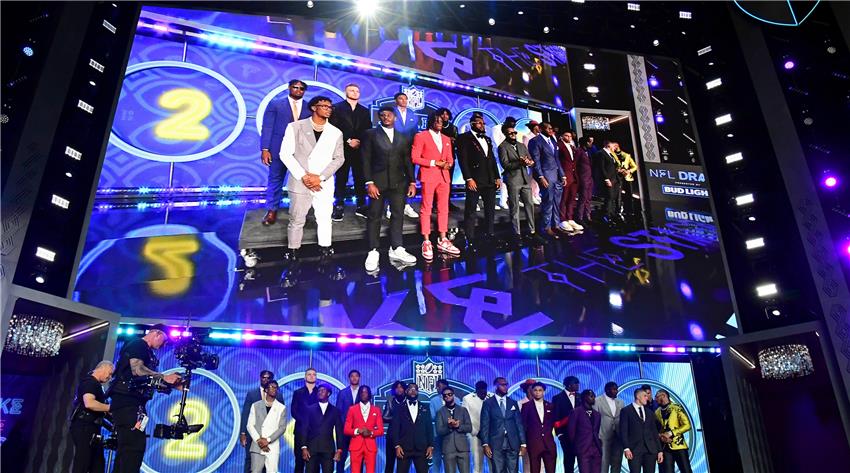
The Compensatory Pick Loophole- Why Free Draft Picks Are Actually Worth Less
How the NFL's compensation formula creates second-class draft selections that cost players millions.
When the Baltimore Ravens selected Roquan Smith with the 99th overall pick in the 2022 NFL Draft, the selection was celebrated as a shrewd move by general manager Eric DeCosta. The Ravens had received the compensatory pick after losing several free agents the previous season, essentially getting a "free" third-round selection to bolster their roster.
But Smith's rookie contract told a different story. Despite being selected in the third round, Smith's four-year deal was worth $4.2 million with $180,000 guaranteed - roughly $300,000 less than players drafted in similar positions during the regular draft. The difference wasn't an oversight or negotiation failure. It was the direct result of the NFL's compensatory pick formula, a complex system that creates a hidden tier of draft selections worth significantly less than their apparent value.
What fans don't realize is that compensatory picks operate under different rules than regular draft selections, creating a two-class system within the same draft round. These picks trade at different values, carry different contract structures, and represent fundamentally different assets for NFL teams - despite appearing identical on draft day television coverage.
The Compensatory Pick Formula Explained
The NFL's compensatory pick system, implemented in 1993, awards additional draft selections to teams that lose more or higher-valued free agents than they sign. The formula considers the contract value, playing time, and postseason honors of departed players, generating up to 32 additional picks distributed among qualifying teams.
These picks are awarded at the end of rounds three through seven, with the exact positioning determined by the compensation formula. A team losing a high-value free agent might receive a third-round compensatory pick, while a team losing a lower-value player might receive a sixth-round selection.
The system was designed to maintain competitive balance by helping teams that lost talent to free agency. In practice, it has created a secondary market of draft picks that operate under different financial and strategic constraints than regular selections.
Former NFL salary cap analyst Mike Ginnitti explained the dynamic: "Compensatory picks look identical to regular picks on TV, but they're fundamentally different assets. The contract slotting is different, the trade rules are different, and the strategic value is different. Teams know this, but fans rarely understand the distinction."
The Contract Slotting Disadvantage
The most significant difference between compensatory picks and regular selections lies in contract slotting. The NFL's rookie wage scale assigns specific salary ranges to each draft position, but compensatory picks receive reduced allocations compared to regular picks in the same round.
This disparity stems from the compensatory pick formula's positioning system. Compensatory picks are awarded at the end of rounds, meaning a compensatory third-round pick might be the 104th overall selection while a regular third-round pick could be the 65th overall selection. The 39-pick difference translates to hundreds of thousands of dollars in rookie contract value.
Take the 2023 draft as an example. Regular third-round picks 65-98 received rookie contracts ranging from $5.1 million to $4.4 million over four years. Compensatory third-round picks 99-106 received contracts worth $4.2 million to $4.0 million. The difference might seem modest, but for players already earning below-market wages on rookie contracts, every dollar matters.
The gap becomes more pronounced when considering guaranteed money. Regular third-round picks in 2023 averaged $220,000 in guaranteed money, while compensatory third-round picks averaged just $180,000. For players facing the inherent injury risks of professional football, this $40,000 difference in guaranteed money represents meaningful financial security.
The Trading Restrictions
Beyond contract considerations, compensatory picks face unique trading restrictions that limit their strategic value. Under current NFL rules, compensatory picks cannot be traded in the year they're awarded. Teams must wait until the following year to include compensatory picks in trade packages.
This restriction creates several strategic disadvantages. Teams cannot use compensatory picks to move up in the current draft, limiting their ability to target specific players. They also cannot package compensatory picks with other assets to create more attractive trade offers during the draft.
The trading restriction also affects the picks' perceived value in trade discussions. When teams evaluate potential trades, they discount compensatory picks compared to regular selections due to the reduced flexibility. A compensatory fourth-round pick might be valued as equivalent to a regular fifth-round pick in trade scenarios.
Green Bay Packers general manager Brian Gutekunst highlighted this challenge: "Compensatory picks are valuable assets, but they're not as flexible as regular picks. When you're trying to move up for a specific player, you can't use your comp picks. It changes your draft day strategy significantly."
The Positional Value Miscalculation
The compensatory pick system also creates positional value distortions that affect both teams and players. Because compensatory picks are awarded based on departed players' contracts and performance, they don't necessarily align with teams' current roster needs.
A team might receive a compensatory pick due to losing a linebacker but actually need help at cornerback. This misalignment can lead to suboptimal draft decisions, where teams reach for players at positions of need rather than selecting the best available talent.
The positional mismatch particularly affects players drafted with compensatory picks. These players often face more pressure to contribute immediately, as teams may have stretched to select them at positions of need rather than natural draft value. This pressure can impact development and long-term success rates.
Statistical analysis of compensatory picks from 2010-2020 shows that players selected with compensatory picks have slightly lower career success rates than players selected at similar positions with regular picks. The difference is modest but measurable, suggesting that the positional value distortions have real consequences for player development.
The Hidden Salary Cap Benefits
While compensatory picks create disadvantages for players, they provide significant salary cap benefits for teams. The reduced contract values of compensatory picks allow teams to add talent at below-market rates, creating additional cap space for other roster moves.
This salary cap advantage is particularly valuable for teams operating near the cap ceiling. A team might save $200,000-300,000 annually by using a compensatory pick instead of a regular selection, allowing them to retain additional veterans or pursue specific free agents.
The cumulative effect of these savings can be substantial. Teams that regularly receive multiple compensatory picks can generate millions in additional cap space over several seasons. This advantage compounds over time, as the saved money can be redirected toward player retention and free agency acquisitions.
However, this benefit comes at the expense of the players selected with compensatory picks. These players effectively subsidize their teams' salary cap management through reduced rookie contracts, creating an inequitable system within the same draft class.
The Strategic Implications
Understanding compensatory pick dynamics reveals why some teams actively manage their free agency strategy to maximize comp pick awards. Teams might avoid signing certain free agents or time their signings to optimize the compensation formula.
The New England Patriots have mastered this strategy under Bill Belichick, regularly receiving multiple compensatory picks by carefully managing their free agency activity. The Patriots' approach demonstrates how the compensatory system can be gamed by savvy organizations.
This strategic manipulation creates competitive advantages for teams that understand the system while disadvantaging organizations that don't optimize their free agency approach. The result is an unintended transfer of draft capital from less sophisticated teams to more analytical organizations.
The system also influences how teams value their own free agents. Teams might be more willing to let certain players walk in free agency knowing they'll receive compensatory picks, while fighting harder to retain players who wouldn't generate compensation.
The Agent's Perspective
Player agents face unique challenges when representing clients selected with compensatory picks. The reduced contract values limit immediate earning potential, while the trading restrictions can affect long-term career opportunities.
Agents must also navigate the psychological aspects of compensatory pick selection. Players selected with these picks might feel like afterthoughts or consolation prizes, potentially affecting their confidence and motivation.
Agent David Canter, who has represented numerous compensatory pick selections, explained the dynamic: "When your client gets drafted with a comp pick, you have to manage expectations differently. The money is less, the perceived value is different, and the path to success might be more challenging. It's about finding the right opportunity within those constraints."
Some agents recommend that compensatory pick clients focus on proving themselves quickly to earn second contracts, as the reduced rookie deal makes the second contract even more crucial for long-term financial security.
The Performance Paradox
Compensatory picks create a performance paradox for the teams that receive them. These picks are awarded based on losing productive players, meaning teams receive compensation precisely when they need to replace lost production.
However, the reduced value of compensatory picks makes it statistically less likely that teams will adequately replace the lost talent. A team losing a starting linebacker worth $8 million annually might receive a compensatory fourth-round pick worth $800,000 annually. The mathematical mismatch is stark.
This paradox helps explain why teams that lose significant free agency talent often struggle the following season, despite receiving compensatory picks. The compensation doesn't match the loss, creating a talent deficit that's difficult to overcome.
The timing delay also compounds this problem. Teams lose free agents in March but don't receive compensatory picks until the following April, creating a full-season gap between loss and compensation. During this period, teams must find alternative solutions that might not be optimal.
The Future of Compensatory Picks
As NFL teams become more sophisticated in their approach to roster building and salary cap management, the compensatory pick system faces increasing scrutiny. The system's complexity and unintended consequences raise questions about its effectiveness and fairness.
Future collective bargaining negotiations might address some of the system's inequities, particularly the contract slotting disadvantages faced by compensatory pick selections. Players' union representatives have expressed concerns about the two-tier system within draft classes.
The trading restrictions might also be reconsidered, as they create artificial constraints on draft day strategy. Allowing compensatory picks to be traded immediately would increase their value and provide more flexibility for teams.
Some analysts have proposed alternative compensation systems that would provide more immediate and equitable value for teams losing free agents. These proposals range from salary cap credits to additional practice squad spots, moving away from the draft pick compensation model entirely.
The Bottom Line
The compensatory pick system represents one of the NFL's most complex and misunderstood mechanisms. While these picks appear to provide free value to teams, the reality is more nuanced. The reduced contract values, trading restrictions, and strategic limitations create a secondary market of draft picks that operate under different rules than regular selections.
For players selected with compensatory picks, the system creates financial and strategic disadvantages that can impact their entire careers. These players earn less on their rookie contracts, face additional performance pressure, and might be viewed as lesser assets despite being selected in the same round as regular picks.
Understanding these dynamics provides crucial context for evaluating draft strategy, player development, and roster construction. The next time you see a team praised for their "free" compensatory picks, remember that in the NFL's complex ecosystem, nothing is truly free. Someone always pays the price - and in this case, it's often the players selected with these seemingly valuable picks.
The compensatory pick loophole reveals a fundamental truth about the modern NFL: the most significant advantages often lie in understanding the system's complexity rather than simply identifying talent. For teams willing to navigate this complexity, compensatory picks offer strategic value. For the players selected with these picks, they represent another example of how the NFL's financial structure can create unexpected career challenges.
